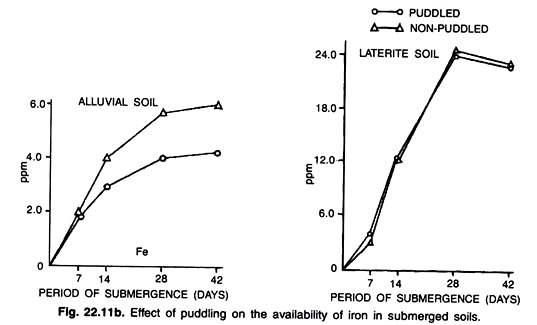ADVERTISEMENTS:
Figure 17.3 shows an infinite slope with a failure surface at depth z, parallel to the slope.
Consider a unit length perpendicular to the slope. Consider a soil element ABCD of width “b” along the slope. So the volume of the element will be –
ADVERTISEMENTS:
V = zb cos β.1 = zb cos β
and the weight of the slice, will be –
W = yzb cos β = γzb cos β
Vertical stress on CD will be –
ADVERTISEMENTS:
σz = W/A = γzb [(cosβ)/(b × 1)] = γzcos β
Resolving σz into its normal and tangential components about the sloping surface
Normal stress will be –
σn = σz cosβ = γz cosβ . cosβ = γzcos2 β
ADVERTISEMENTS:
Shear stress will be –
τ = σz sin β = γz cos β sinβ
Factor of Safety for a Dry Cohesionless Soil Slope:
When full shear resistance is mobilized on the plane, shear strength along CD is –
τf = σn tan ɸ‘ = γz cos2 β tan ɸ’
ADVERTISEMENTS:
Factor of safety against shear failure is –
Factor of Safety for a Submerged Cohesionless Soil Slope:
If the slope is submerged, the submerged density and the effective normal stress should be used in the computation of the factor of safety Thus, for a submerged slope, shear strength along CD is –
τf = σn tan ɸ’ = γ’z cos2 β tan ɸ’
ADVERTISEMENTS:
Factor of safety against shear failure is,
Thus, the factor of safety of an infinite slope is the same if the slope is completely dry or completely under submerged conditions, as shown in Eqs. (17.5) and (17.6).
Factor of Safety for a Cohesionless Soil Slope with Seepage Parallel to the Slope:
Figure 17.4 shows an infinite slope with seepage parallel to the slope, with a failure plane at a depth of z below the surface, and water surface at any height h above the failure surface. So,
Factor of safety against shear failure will be –
Factor of Safety for a Cohesive Soil Slope:
The soil slope can be either dry or submerged or seepage may occur parallel to the slope.
These cases are considered in the following subsections:
1. Factor of Safety for a Dry Cohesive Soil Slope:
Factor of safety against shear failure is given by –
Thus, the factor of safety for cohesive soil depends not only on ɸ and P but also on γ, H, and C. For F = 1, z in Eq. (17.9) gives the critical height, Hc –
Or, the critical height for dry cohesive soil slope is given by –
Reframing Eq. (17.10), we get –
where Sn is called the stability number, defined by Eq. (17.11) for an infinite cohesive soil slope.
2. Factor of Safety for a Submerged Cohesive Soil Slope:
Factor of safety against shear failure for a submerged slope is given by –
The critical height for submerged cohesive soil slope is given by –
3. Factor of Safety for a Cohesive Soil Slope with Steady Seepage Parallel to Slope:
Factor of safety against shear failure for a cohesive slope with seepage parallel to the slope is given by –
The critical height for cohesive soil slope with seepage parallel to slope is given by –









